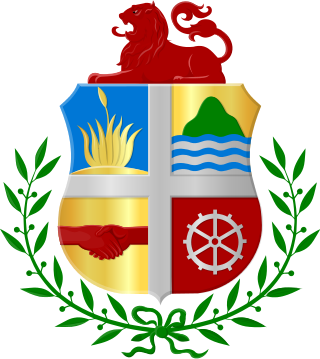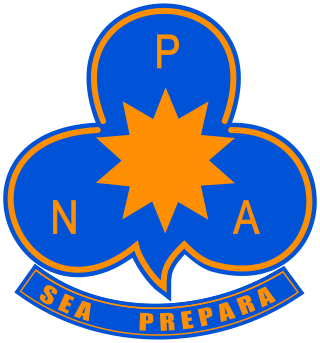
The Netherlands Antilles, also known as the Dutch Antilles, was a constituent Caribbean country of the Kingdom of the Netherlands consisting of the islands of Saba, Sint Eustatius, and Sint Maarten in the Lesser Antilles, and Aruba, Curaçao, and Bonaire in the Leeward Antilles. The country came into being in 1954 as the autonomous successor of the Dutch colony of Curaçao and Dependencies, and it was dissolved in 2010, when like Aruba in 1986, Sint Maarten and Curaçao gained status of constituent countries within the Kingdom of the Netherlands, and Saba, Sint Eustatius, and Bonaire gained status of special municipality of Netherlands as the Caribbean Netherlands. The neighboring Dutch colony of Surinam in continental South America, did not become part of the Netherlands Antilles but became a separate autonomous country in 1954. All the territories that belonged to the Netherlands Antilles remain part of the kingdom today, although the legal status of each differs. As a group they are still commonly called the Dutch Caribbean, regardless of their legal status. People from this former territory continue to be called Antilleans in the Netherlands.

The Coat of arms of Aruba has been officially in use since November 15, 1955, as the recognized national symbol of Aruba.

Gilberto François "Betico" Croes was an Aruban political activist who was a proponent for Aruba's separation from the Netherlands Antilles. This eventually occurred in 1986, but following a car accident on 31 December 1985, Croes lapsed into a coma and never became conscious to see his accomplishment. He is best remembered as "Libertador" (liberator) and as the father of the Aruban people.

The Netherlands Antilles national football team was the national team of the former Netherlands Antilles from 1958 to 2010. It was controlled by the Nederlands Antilliaanse Voetbal Unie. The NAVU consisted of Curaçao and Bonaire. Aruba split in 1986 and has its own team.
The Constitution of the Netherlands Antilles was proclaimed on 29 March 1955 by Order-in-Council for the Kingdom. Its proclamation was specifically mandated by article 59(4) of the Charter for the Kingdom of the Netherlands, which had been enacted on 15 December 1954. Together with the Island Regulation of the Netherlands Antilles, the Constitution describes the foundation of the government of the Netherlands Antilles.

The Netherlands Antillean guilder is the currency of Curaçao and Sint Maarten, which until 2010 formed the Netherlands Antilles along with Bonaire, Saba, and Sint Eustatius. It is subdivided into 100 cents. The guilder was replaced on 1 January 2011 on the islands of Bonaire, Saba and Sint Eustatius by the United States dollar.
Below is a list of prime ministers of the Netherlands Antilles from 1951 to 2010. In 2010 the position of Prime Minister of the Netherlands Antilles was abolished, together with the dissolution of the country itself.

The Parliament of the Netherlands Antilles, also translated as the Estates of the Netherlands Antilles, was the parliament of the Netherlands Antilles. It comprised 22 members, elected for a four-year term in three multi-seat constituencies and two single-seat constituencies. On 10 October 2010, the Netherlands Antilles were dissolved, and so was the parliament.

"Tera di Solo y suave biento", also known as the "Himno di Boneiru" and originally the "Himno Boneriano", is the anthem of Bonaire, a special municipality of the Netherlands in the Caribbean. The music was composed by J.B.A. (Tony) Palm, and the official lyrics, which are in Papiamentu, were written by Hubert (Lio) Booi (1919–2014). From 1964 to 2000, it also served as the anthem of the Netherlands Antilles.

The Padvindstersvereniging van de Nederlandse Antillen is the national Guiding organization of the former Netherlands Antilles. It serves 461 members. Founded in 1930, the girls-only organization became an associate member of the World Association of Girl Guides and Girl Scouts in 1978 and full member in 1981.

The Charter for the Kingdom of the Netherlands is a legal instrument that sets out the political relationship among the four countries that constitute the Kingdom of the Netherlands: Aruba, Curaçao, Sint Maarten in the Caribbean and the Netherlands in Europe. It is the leading legal document of the Kingdom. The Constitution of the Netherlands and the Basic Laws of the three other countries are legally subordinate to the Charter.

The Netherlands Antilles was an autonomous Caribbean country within the Kingdom of the Netherlands. It was dissolved on 10 October 2010.
The Joint Court of Justice of Aruba, Curaçao, Sint Maarten, and of Bonaire, Sint Eustatius and Saba serves the three Caribbean countries of the Kingdom of the Netherlands and the three Caribbean special municipalities of the Netherlands. The court primarily hears disputes in first instance and on appeal of these six islands, and is on the same level as similar courts in the Netherlands. Since 2012, the court has also been authorized to hear inquiry procedures originated on Curaçao, of a type that would be heard in the Netherlands by the Enterprise Chamber in Amsterdam.

The Kingdom of the Netherlands, commonly known simply as the Netherlands, is a sovereign state consisting of a collection of constituent territories united under the monarch of the Netherlands, who functions as head of state. The realm is not a federation; it is a unitary monarchy with its largest subdivision, the eponymous Netherlands, predominantly located in Northwestern Europe and with several smaller island territories located in the Caribbean.

The Caribbean Netherlands is a geographic region of the Netherlands located outside of Europe, in the Caribbean, consisting of three special municipalities. These are the islands of Bonaire, Sint Eustatius, and Saba, as they are also known in legislation, or the BES islands for short. The islands are officially classified as public bodies in the Netherlands and as overseas territories of the European Union; as such, European Union law does not automatically apply to them.

The Colony of Curaçao and Dependencies was a Dutch colony in the Caribbean Sea from 1634 until 1828 and from 1845 until 1954. Between 1936 and 1948, the area was officially known as the Territory of Curaçao, and after 1948 as the Netherlands Antilles. With the proclamation of the Charter for the Kingdom of the Netherlands on 15 December 1954, the Netherlands Antilles attained equal status with the Netherlands proper and Suriname in the new Kingdom of the Netherlands.
An island council was the governing body of an island territory, an administrative level of the Netherlands Antilles until its dissolution.
This article lists some of the events from 1951 related to the Netherlands.
Island council elections were held in the Netherlands Antilles in 1955. They were the second elections for the Island Council.

The island territories of the Netherlands Antilles were the top-level administrative subdivisions of the Netherlands Antilles. The government of each island territory consisted of three major parts:













